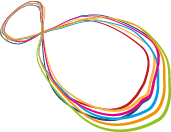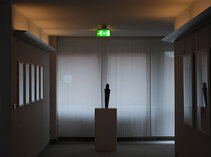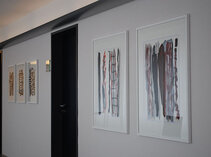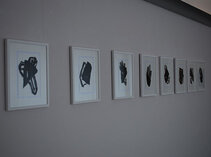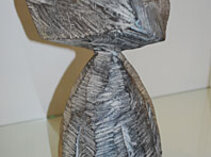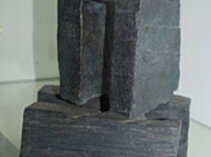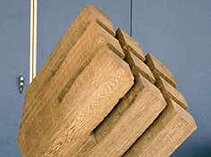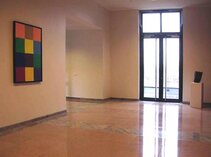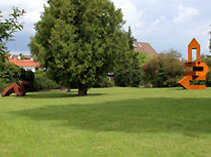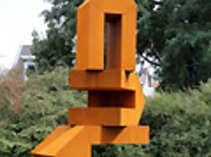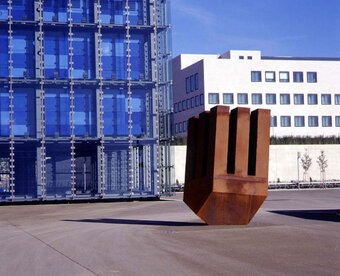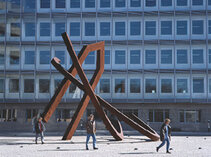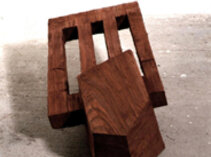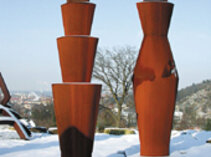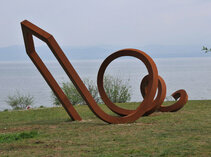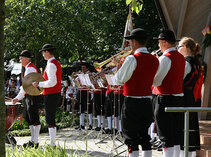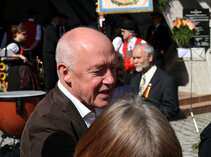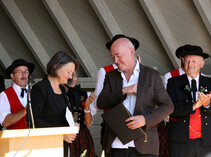Werner Pokorny
January 31 to March 11, 2011: Drawing and small sculpture"Time becomes space here" - this Wagnerian phrase from "Parsifal" may sound too pathetic, but in view of these and similar Pokorny perspectives, you can feel how time coagulates.
What remains is space - timeless and melancholy. The reliably slanted figure leans into its reflection and out of the picture frame from which it seems to have emerged.
You should walk along the picture walls several times and read into the figurations. Then the walls dissolve into a filigree and decidedly vertical pattern. The magic may work: The walls gain space.
The attraction of looking at a Pokorny drawing lies in transforming it into a small sculpture. This may succeed quickly, as the artistic guidelines are clear. Practiced in the ceremonial of transformation, the viewers in front of the showcases on the first floor may finally solve a tricky task, namely to return the sculptures to the second dimension, to see them as drawings.
Pokorny works primarily as a sculptor. He has decorated urban spaces and parks with numerous large sculptures. The small sculptures convey a vivid idea of the monumentality of his works.

wheels I-III, 2009
Vita
- Born in Mosbach in 1949.
- works and teaches as a professor for general artistic education at the State Academy of Fine Arts Stuttgart. Main focus: sculpture.
Time coagulates - what remains is space
At the beginning of 2011, Werner Pokorny exhibited drawings and small sculptures at the University Heart Center. In the middle of a relatively short section of corridor leading to a bright window stands a silent stele, flanked by picture supports whose contents are not recognizable due to the steep perspective. Not quite right. On the right, a reflection reveals the stele's doppelganger. He seems to be leaning forward, as if he wanted to reveal himself to his counterpart. The scenario has changed and the exhibition mode is switched off. Time coagulates - what remains is space!
Mirroring or not, it doesn't matter. But the question arises: Is this the Pokorny? An interesting juxtaposition could provide the first answers. In a meeting room in the administration wing, a wooden sculpture entitled "Pfeiler aufrecht" (1994) is displayed on a low cabinet. Years later, a new wing was added to the Heart Center, the Roskamm House. The curator distributed and arranged the extensive art collection, some of which had been hidden away in the archive. The wooden sculpture was given a new place, finally a place where it could breathe and unfold. It immediately entered into a dialog with Rolf-Gunter Dienst's "Scaramouche" from 2000 and eagerly exchanged thoughts with a close relative, the Pokorny ink drawing from 2010, which hangs rather shyly behind the "Dienst wall" next to a doorway, but can be seen from the "upright pillars".
Pokorny needs space, and the space is dependent on Pokorny at certain times. The latter took place last year in 2012 in the sculpture park in Möhrfelden/Hesse. The artist was invited to place his sculptures. His house tower, viewed from a distance, draws the space together. At first, the house icons made of Corten steel and placed on top of each other appear to be part of the city silhouette. But if you walk towards them with deliberate steps, the structure comes towards you, almost demanding the viewer's proximity. And it is similar with the other spatial objects, forming an object-space. So here too: The exhibition mode is switched off.
Many visitors were delighted. They quickly became friends with the sculptures - and thus probably also with the park, which has now taken on a new role in their living space.
You have to create Pokorny's object spaces for yourself. It is not enough to understand the sculptures as individual objects in order to appreciate their form, construction or composition. You are left on the outside and go back to business as usual - the next day they are forgotten. Instead, you can experience how a well-known space, a park or an urban environment changes and is transformed into a temporary timelessness. You feel that you have experienced a kind of increase in reality. Pokorny's sculptures sharpen our senses for the perception of reality by opening up areas into which we have never looked before.
While full of large sculptures in the park or in an urban setting, the small sculptures suddenly appear monumental.
Back to the University Heart Center! We consider the wooden sculpture "Pfeiler aufrecht" from 1994 to be a manageable object. A certain miniaturization would even be conceivable, for example in the style of his small sculptures. Suppose we were to select DIN A4 images of a small sculpture, the "upright pillars" and the "house tower" (without background) and place them next to each other, could we then decide on their proportions? Admittedly, the surface structure of the small sculptures may possibly be an indication of their dimensions, but we would find it difficult to determine the size of the other objects. The reason is obvious, or rather obvious to the eye. Pokorny's rhetoric is perfect, as the formations are legible and unambiguous in their legibility. The composition is coherent, no matter from which side I look at the object. The miniature can unfold its effect and atmosphere as a monumental object and vice versa. One example is the "9 pillars upright" on the grounds of the ZKM in Karlsruhe from 1994. We recognize in it the wooden sculpture "Pfeiler aufrecht" from the University Heart Center - only in a dimension of 420x300x150 cm.
According to a maxim, simplicity is always the right thing. That's easy to say, but is it true? Let's test this assertion by looking at the motifs of the sculptures. Two groups can be distinguished, the object-related and the figurative motifs. The first group includes a house, gate, vessel or frame. The second group could be described as lines, curves and curvatures. The different types of motifs are often combined with each other, such as the "House Tower" or "Spiral and House" from 1986. On the other hand, figurative elements form into objects, as demonstrated by the "Wheels I-III" from 2009, or representational motifs merge into figurative elements, such as the "House with Openwork Form III" from 1992. The motif structure is clearly organized because it is simple. The drawings, whose motifs are similar, are symptomatic of the correctness of simplicity. Due to the clear artistic guidelines, each drawing can be "read" as a sculpture. The motif structure is simple and therefore correct, as the results prove.
If there was talk above of a specific "Pokorny rhetoric", its building blocks should be defined in more detail. The artist is concerned with the means and techniques of producing and presenting his sculptures. He does not see the goal exclusively in the successful design of the object. This is a matter of course for him. The sculpture was created for a space, so that the conception and the work processes are always accompanied by the spatial context of his work. He brings his works to life in a park, on a busy city square, in a museum or in a private setting. In doing so, he achieves something unique: creating identity through art.
Ehrenfried Kluckert
Presentation of the Hans Thoma Prize on August 11, 2013 in Bernau
The Hans Thoma Prize was established in 1949 in honor of the painter, academy and gallery director Hans Thoma (1839 - 1924). The award, which is presented every two years, has already honored many renowned artists, including Emil Wachter, Otto Dix and Anselm Kiefer.
This year, the honor goes to Werner Pokorny.
This was the conclusion reached by the jury convened by the Baden-Württemberg Ministry of Science, Research and the Arts and chaired by State Secretary Jürgen Walter. It was composed as follows: Petra von Olschowski (Akademie der Bildenden Künste Stuttgart), Dr. Nicole Fritz (Kunstmuseum Ravensburg), Johan Holten (Staatliche Kunsthalle Baden-Baden), Dr. Holger Jacob-Friesen (Staatliche Kunsthalle Karlsruhe) and Dr. Tilmann von Stockhausen (Augustinermuseum Freiburg). Rolf Schmidt, Mayor of the municipality of Bernau im Schwarzwald, took part in an advisory capacity
District President Bärbel Schäfer presents the prize to the artist. Prior to this, she paid tribute to Pokorny's work, including the jury's statements: "The sculptor has developed his own formal language, in which the significance of the elementary sign is the focus through reduction and clarification. His early wooden sculptures thematized the relationship between art and nature with references to trees, roots and branches. These remained clearly visible as part of the working process. His works in steel revolve around archetypal models such as the house, vessel, bowl, vase or sphere. After Pokorny's words of thanks, the rector Petra von Olschowski from the State Academy of Fine Arts in Stuttgart, where Pokorny worked as a professor, held the laudatory speech.

